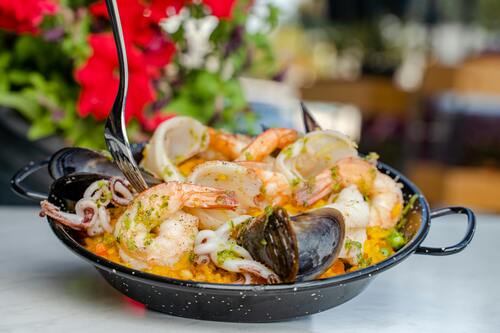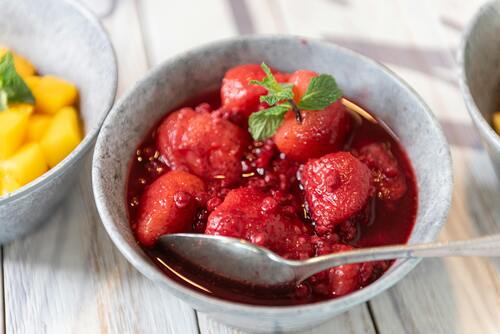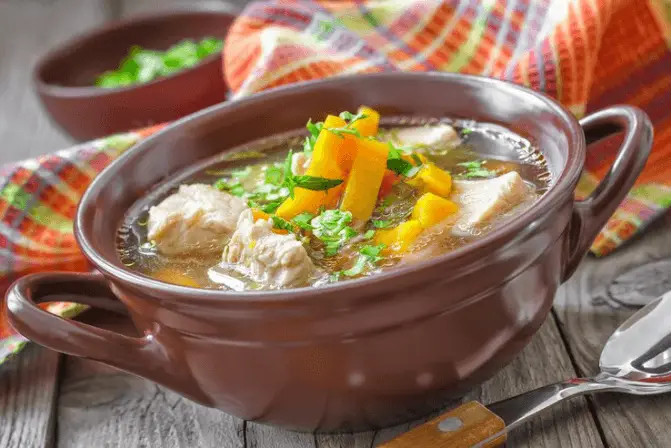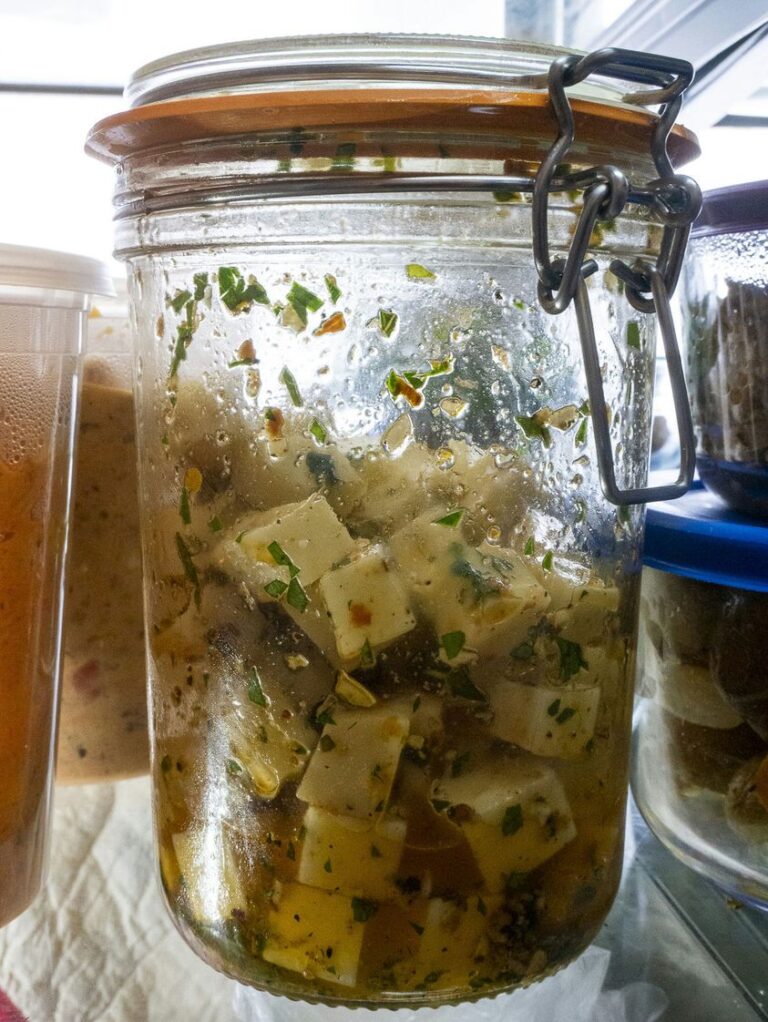A Spanish Classic You Must Taste: Seafood Paella

Paella is a celebration of food and friendship since it is typically served in a large, shallow pan, which encourages sharing and community. Offering a thorough overview of this famous meal, this page will explore the background, key components, preparation methods, and regional variants of seafood paella. You’ll find ideas for making your own seafood paella and bringing a little bit of Spain into your house, regardless of your level of culinary experience.
Paella’s Rich History
Paella’s history dates back to the middle of the 19th century in Valencia’s rural areas, when it was first made by farmers and laborers. Traditionally prepared with easily accessible local ingredients in a broad, shallow pan known as a “paellera,” the dish was cooked over an open fire in the fields. In keeping with the area’s agricultural heritage, the original version frequently featured snails, chicken, and rabbit. The seafood paella that we know today was created when Valencia’s seaside location gained prominence and seafood started to play a big part in the dish. Paella has changed over time, with many variations and interpretations appearing both inside and outside of Spain. Paella is a beloved aspect of Spanish culture and cuisine because, despite its changes, its fundamental qualities remain anchored in its communal nature, which brings people together to enjoy a hearty meal.
Key Components of Seafood Paella

A careful selection of ingredients is necessary to create the ideal seafood paella, which adds to its distinct flavor and texture. The rice is the major ingredient in this recipe; short-grain types, such as Bomba or Calasparra, are favored because they can absorb liquid while staying firm. Known as the “golden spice,” saffron is essential for giving the food its distinctive flavor and color. The main attraction is fresh seafood, which usually includes firm white fish like cod or monkfish, prawns, mussels, and clams. Tomatoes provide depth and acidity, while aromatics like bell peppers, onions, and garlic make the dish’s foundation. A high-quality fish or seafood stock serves as the liquid foundation for boiling the rice, and olive oil is necessary for sautéing the ingredients. Lastly, lemon wedges and fresh parsley are frequently used as garnishes to add taste and brightness. These components work together to produce a flavorful fusion that makes seafood paella a dish that people will never forget.
The Step-by-Step Guide to Cooking Paella
Seafood paella cooking is both an art and a science that calls for patience and close attention to detail. First, heat the olive oil in a broad shallow skillet or a large paellera over medium heat. Add bell peppers, diced onions, and garlic and sauté until fragrant and tender. Add the diced tomatoes next, and simmer until the sauce thickens into a sofrito. Add the rice and stir, letting it toast a bit in the oil to improve its taste. Make sure the rice is properly divided before adding the saffron and seafood stock. When the mixture is simmering, place the shellfish on top of the rice, being careful not to stir, as this will break up the socarrat, which is the coveted crispy layer at the bottom of the pan. Cook for about 20 minutes, or until the rice is soft and the liquid has been absorbed. Before serving, let the paella sit for a few minutes so that the flavors may combine. Paella is a beloved meal that embodies the spirit of Spanish culinary culture because of this painstaking technique.
Socarrat’s Significance

The socarrat, or crispy bottom layer of rice that develops while cooking, is one of the hallmarks of a well-prepared paella. This valued component, which is frequently characterized as nutty or roasted, offers a distinctive texture and flavor. Timing and heat must be carefully balanced to create the ideal socarrat. The paella is typically cooked over an open flame so that the rice cooks through and the bottom layer caramelizes. To encourage the socarrat to form, start the stovetop on medium heat and then turn it up a bit toward the end of cooking. Stirring the rice after adding the broth is crucial because it will stop the socarrat from developing. Rather, leave the paella alone to cook until the rice is soft and the liquid has been absorbed. Many fans will compete to have the greatest bits of this delectable crust because the socarrat is frequently regarded as the pinnacle of paella.
Paella’s Regional Variations
Even though seafood paella is one of the most well-liked varieties, paella is available in a variety of regional variations throughout Spain. Paella originated in Valencia, and the region’s agricultural heritage is reflected in the traditional dish’s frequent inclusion of rabbit, chicken, and snails. Coastal regions use the freshest catch of the day and prefer seafood varieties. Another well-known variation is “mixed paella,” which offers a distinctive flavor combination by combining both meat and shellfish. Local ingredients and cooking techniques give each region its own unique spin. For instance, a seafood fideuà, a noodle-based dish, has become a popular substitute in Catalonia, while a seafood paella enhanced with regional herbs and spices may be found in the Basque Country. These regional versions demonstrate the versatility of paella, a dish that can be eaten in a multitude of ways, in addition to showcasing the diversity of Spanish cuisine.
Combining Wine with Other Drinks
Making the correct beverage selection to go with seafood paella can improve the entire eating experience. Typically, a crisp white wine, such Verdejo or Albariño, provides acidity that balances the dish’s richness while enhancing the flavors of the seafood. A light-bodied wine like Garnacha might also be a good choice if you like red wine, especially if your paella contains meat. A handmade citrus soda or crisp sparkling water with a lemon twist are good non-alcoholic options for people who want to clear their palate in between bites. A light Spanish beer, such a lager or a cerveza, can also be a lovely addition, giving the meal a relaxed, celebratory feel. The ultimate objective is to select a drink that enhances the enjoyment of this shared meal while balancing the tastes of the paella.
How to Prepare the Ideal Paella

There are a number of strategies and suggestions that might help you make a perfect seafood paella. First, always use quality ingredients, especially seafood, which will taste best when it is fresh and sustainable. The general rule is two parts liquid to one part rice, however this might vary based on the type of rice being used. Keep this in mind when boiling the rice. After adding the broth, do not mix the rice because this will stop the socarrat from forming. In order to allow the flavors to combine and the rice to firm up a bit, it is also advantageous to let the paella rest for five to ten minutes after cooking before serving. Exciting outcomes can also be obtained by experimenting with other seafood combinations; feel free to use whatever is available or in season in your area. Last but not least, don’t be afraid to include your own flair into your seafood paella by adding special garnishes, herbs, or spices.
Paella’s Cultural Significance
In addition to its delectable flavors, paella has a special meaning in Spanish culture as a symbol of solidarity and community. Paella is typically served at get-togethers, festivities, and family dinners where loved ones and friends meet to exchange food and tales. Family members frequently help with the preparation and cooking of paella, making it a community activity. Local celebrations of paella’s cultural significance and geographical diversity can be seen throughout Spain. The dish, which is regarded as a gastronomic gem globally, has also come to represent Spanish identity. Recognizing the cultural significance of paella makes eating it more enjoyable and encourages diners to value the customs and history that have influenced this well-loved dish over time.
Creating a Tradition of Paella in the Family
Making seafood paella can become a treasured family ritual in addition to being a delicious dinner. Bringing loved ones together to cook and eat this meal together strengthens bonds and produces enduring memories. Whether it’s slicing veggies, measuring ingredients, or stirring rice, encourage family members to help out in the kitchen. The experience is enhanced by telling stories and laughing together while cooking, turning the dinner into a celebration of community. To make paella a family tradition that everyone looks forward to, think about setting aside a specific day or event. You can try different ingredients or variants at every get-together, making sure that the custom changes but remains anchored in the delight of sharing food. In addition to honoring the dish’s cultural significance, making seafood paella a family custom fosters a legacy of love and camaraderie at the dinner table.
Final thoughts
More than just a tasty dish, seafood paella captures the essence of coastal cooking, which is full of vibrant flavors, fresh ingredients, and a sense of community. Everything about this coastal delight, from its lengthy history to the thoughtful choice of fish and toppings, adds to the total experience. You can experiment with different flavors and textures by customizing seafood paella to fit any palette thanks to its countless varieties and inventive possibilities. In addition to enjoying the flavor of the ocean, you will make enduring memories as you and your loved ones assemble around the table to enjoy these delicious delicacies. Explore the world of seafood paella and enjoy the coastal delight they provide to your dining table, regardless of your level of taco expertise or familiarity with this culinary gem.






